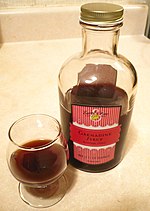
Grenadine /ˈɡrɛnədiːn/ is a commonly used nonalcoholic bar syrup characterized by its deep red color. It is a popular cocktail ingredient renowned for its flavor as well as its ability to give a reddish or pink tint to mixed drinks. Grenadine was traditionally made from pomegranate but is more often encountered as a commercial imitation with few to no actual fruit components.
Etymology and origin[edit]
The name "grenadine" originates from the French word grenade, which means pomegranate, from Latin grānātum "seeded" (and possibly related to "pomme" which is the French word for apple). Grenadine was originally prepared from pomegranate juice, sugar, and water.[1] It is not related to the Grenadines archipelago, which takes its name from Grenada, which is itself named for Granada, Spain.[2]
Modern and commercial variants[edit]
As grenadine is subject to minimal regulation, its basic flavor profile can alternatively be obtained from a mixture of blackcurrant juice and other fruit juices, with the blackcurrant flavor dominating.[3]
To reduce production costs, manufacturers have widely replaced fruit bases with artificial ingredients. The Mott's brand "Rose's" is by far the most common brand of grenadine sold in the United States,[4] and is formulated from (in order of concentration) high fructose corn syrup, water, citric acid, sodium citrate, sodium benzoate, FD&C Red #40, natural and artificial flavors, and FD&C Blue #1.[5]
In recent years, better quality craft grenadines made using pomegranate juice have been brought into commerce.
Use in cocktails[edit]

Grenadine is commonly used to mix both modern and classic cocktails, including:
- El Presidente – rum, orange curaçao, vermouth, and grenadine
- Mary Pickford – white rum, pineapple juice and grenadine
- Queen Mary – beer, grenadine and maraschino cherries, drizzled with cherry syrup
- Singapore Sling – a gin-based sling cocktail
- Tequila Sunrise – tequila, orange juice and grenadine
- Ward 8 – "a whiskey sour with a few dashes of grenadine added"[6]
- Zombie – a rum-based Tiki cocktail
Grenadine is also a popular ingredient in some non-alcoholic drinks, such as the Roy Rogers, pink lemonade, and Shirley Temple cocktails, or simply mixed with cold water or soda in a glass or jug, sometimes with ice.
See also[edit]
References[edit]
- ^ Dictionnaire Universel de Cuisine Pratique : Encyclopédie Illustrée D'Hygiène Alimentaire, Joseph Favre, Paris, 1905, pp. 1088.
- ^ Fodor's Barbados, St. Lucia, St. Vincent, the Grenadines & Grenada. Fodor's Travel. December 28, 2010. ISBN 9780307928030 – via Google Books.
- "Grenadines Island Group (Grenada)". UNESCO World Heritage Centre. - ^ Food and Drug Administration (January 10, 1980). "Sec. 550.400 Grenadine". CPG 7110.11. Retrieved August 23, 2009.
- ^ "Media Release: Cadbury Schweppes to Acquire Snapple Beverage Group for an Enterprise Value of $1,450 Million". Cadbury Schweppes. September 18, 2000. Archived from the original on June 12, 2004. Retrieved July 5, 2008.
- ^ "Wegmans - Rose's Grenadine Ingredients". Archived from the original on November 6, 2010.
- ^ Apple Jr., R.W. (February 20, 2002). "Male Bastion, 108, Saved By a Boss Named Lydia". New York Times. Retrieved December 4, 2022.
External links[edit]
 Media related to Grenadine at Wikimedia Commons
Media related to Grenadine at Wikimedia Commons